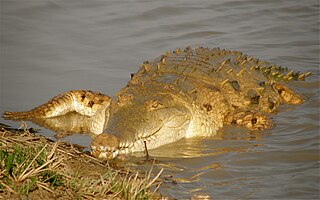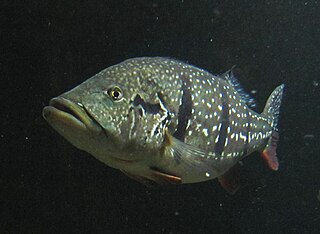Bass is a generic common name shared by many species of ray-finned fish from the large clade Percomorpha, mainly belonging to the orders Perciformes and Moroniformes, encompassing both freshwater and marine species. The word bass comes from Middle English bars, meaning "perch", despite that none of the commonly referred bass species belong to the perch family Percidae.

The Orinoco is one of the longest rivers in South America at 2,250 kilometres (1,400 mi).

The Amazon river dolphin, also known as the boto, bufeo or pink river dolphin, is a species of toothed whale endemic to South America and is classified in the family Iniidae. Three subspecies are currently recognized: I. g. geoffrensis, I. g. boliviensis and I. g. humboldtiana while position of Araguaian river dolphin within the clade is still unclear. The three subspecies are distributed in the Amazon basin, the upper Madeira River in Bolivia, and the Orinoco basin, respectively.

The Iguazu River, also called Rio Iguassu, is a river in Brazil and Argentina. It is an important tributary of the Paraná River. The Iguazu River is 1,320 kilometres (820 mi) long, with a drainage basin of 62,000 square kilometres (24,000 sq mi).

Gatun Lake is a freshwater artificial lake to the south of Colón, Panama. At approximately 26 m (85 ft) above sea level, it forms a major part of the Panama Canal, carrying ships 33 km (21 mi) of their transit across the Isthmus of Panama. It was created June 27, 1913 when the gates of the spillway at Gatun Dam were closed. The water level was about 14.6 m (48 ft) above sea level and was expected to fill to operating levels in the next six months.

Peacock bass or Brazilian tucunaré are large freshwater cichlids of the genus Cichla. These are diurnal predatory fishes native to the Amazon and Orinoco basins, as well as rivers of the Guianas, in tropical South America. They are sometimes referred to in English by their Brazilian name tucunaré or their Spanish name pavon. Despite the common name and their superficial similarity, they are not closely related to other fish known as bass, such as the North American largemouth bass.

The Chagres River, in central Panama, is the largest river in the Panama Canal's watershed. The river is dammed twice, and the resulting reservoirs—Gatun Lake and Lake Alajuela—form an integral part of the canal and its water system. Although the river's natural course runs northwest to its mouth at the Caribbean Sea, its waters also flow, via the canal's locks, into the Gulf of Panama to the south. The Chagres thus has the unusual claim of drainage into two oceans.

The Arrau turtle, also known as the South American river turtle, giant South American turtle, giant Amazon River turtle, Arrau sideneck turtle, Amazon River turtle or simply the Arrau, is the largest of the side-neck turtles (Pleurodira) and the largest freshwater turtle in Latin America. The species primarily feeds on plant material and typically nests in large groups on beaches. Due to hunting of adults, collecting of their eggs, pollution, habitat loss, and dams, the Arrau turtle is seriously threatened.

The Orinoco crocodile is a critically endangered crocodile. Its population is very small, and they can only be found in the Orinoco river basin in Venezuela and Colombia. Extensively hunted for their skins in the 19th and 20th centuries, it is one of the most endangered species of crocodiles. It is a very large species of crocodilian; males have been reported up to 6.8 m in the past, weighing over 900 kg (2,000 lb), but such sizes do not exist today, 5.2 m being a more widely accepted maximum size. A large male today may attain 4.2 m in length and can weigh up to 450 kg (1,000 lb), while females are substantially smaller with the largest likely to weigh around 225 kg (496 lb). Sexual dimorphism is not as profound as in other crocodilian species. The coloration is light even in adults.

The black arowana is a South American freshwater bony fish of the family Osteoglossidae. Black arowanas are sometimes kept in aquariums, but they are predatory and require a very large tank. It is generally common, but large numbers are caught as food and for the aquarium fish trade.

Cichla orinocensis, sometimes known as the Orinoco peacock bass, tucunaré or tucunaré miri, is a very large species of cichlid. This peacock bass is native to the Rio Negro and Orinoco River basins in northern South America. It mainly occurs in blackwater rivers. Despite the name, it is not the only peacock bass in the Orinoco, as the river also is home to C. intermedia, C. nigromaculata, and C. temensis. Where it overlaps with the last species, C. orinocensis prefers more slow-moving and shallow waters. They are able to tolerate more turbid waters than other species of peacock bass.

The ocellate river stingray, also known as the peacock-eye stingray or black river stingray, is a species of freshwater stingray in the family Potamotrygonidae. It was the first species to be described in the family and is also the most widespread, ranging throughout much of the Río de la Plata, Amazon, Mearim and Orinoco basins in tropical and subtropical South America. It is sometimes kept in aquaria.

Cichla ocellaris, sometimes known as the butterfly peacock bass, is a very large species of cichlid from South America, and a prized game fish. It reaches 74 cm (29 in) in length. It is native to the Marowijne and Essequibo drainages in the Guianas, and the Branco River in Brazil. It has also been introduced to regions outside its natural range, but some uncertainty exists over the exact identity, and at least some of the introductions may involve another Cichla species or hybrids. It is frequently confused with C. monoculus. Studies conclude that the introduction of Cichla ocellaris does not negatively impact fish communities in Florida, making it an effective fisheries management tool.

The giant cichlid, also known as the emperor cichlid, is a species of fish in the family Cichlidae, endemic to Lake Tanganyika in Africa. It is the only member of its genus Boulengerochromis and tribe Boulengerochromini.

Gatun is a small town on the Atlantic Side of the Panama Canal, located south of the city of Colón at the point in which Gatun Lake meets the channel to the Caribbean Sea. The town is best known as the site of the Panama Canal's Gatun Locks and Gatun Dam, built by the United States between 1906–1914.

Cichla temensis, the speckled pavon, speckled peacock bass, painted pavon, or three-barred peacock bass, is a very large South American cichlid, and a prized food and game fish. Reaching up to 1 m (3.3 ft) in length and 13 kg (29 lb) in weight, it is the largest cichlid of the Americas, and perhaps the largest extant cichlid in the world, with only the African giant cichlid possibly reaching similar proportions.

Cinaruco River is a river of Colombia and Venezuela. It is part of the Orinoco River basin. It has partially clear tanic waters. In Venezuela this river is part of the Santos Luzardo National Park since the year 1988. The Cinaruco River together with the Capanaparo River, other smaller rivers and the area around them form this national park. It houses a big biodiversity and many fishermen go each year looking for peacock bass. Three different species of peacock bass are found in this river: Cichla intermedia, Cichla orinocensis and Cichla temensis from smallest to biggest.

Cichla monoculus, sometimes known as the tucanare peacock bass or toukounaré, is a very large species of cichlid, and a prized game fish. It is native to the Amazon basin in South America, but has also been introduced to regions outside its natural range. It reaches 80 cm (31 in) in length and 9 kg (20 lb) in weight.
Hyphessobrycon acaciae is a species of South American tetra fish, belonging to the family Characidae.
Bryconops vibex is a small freshwater fish from the rivers of Venezuela, known solely from the Rio Cataniapo. The body is slender, though with an element of sturdiness, and it has one humeral spot by each pectoral fin. It bears visual similarities to several congeners, but can be differentiated by way of many factors.

















